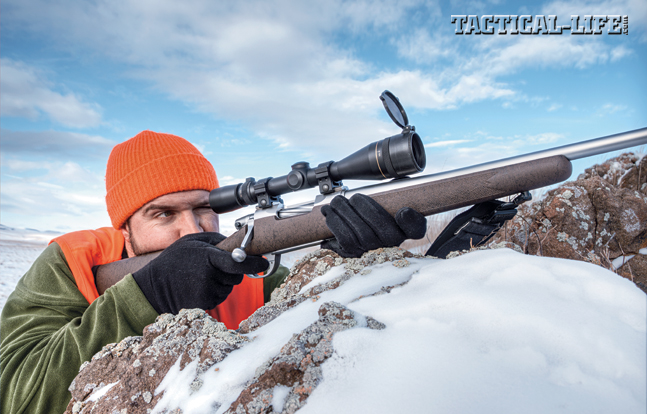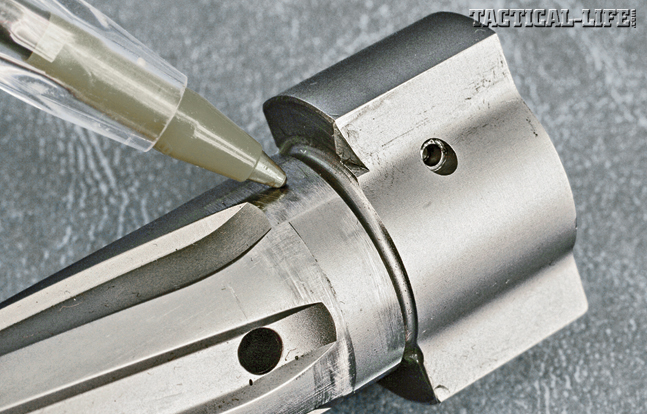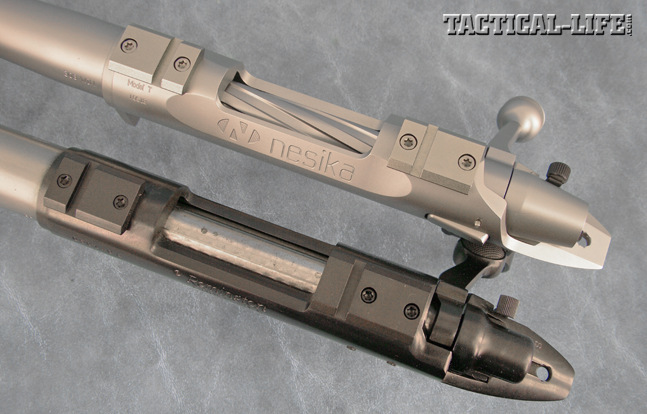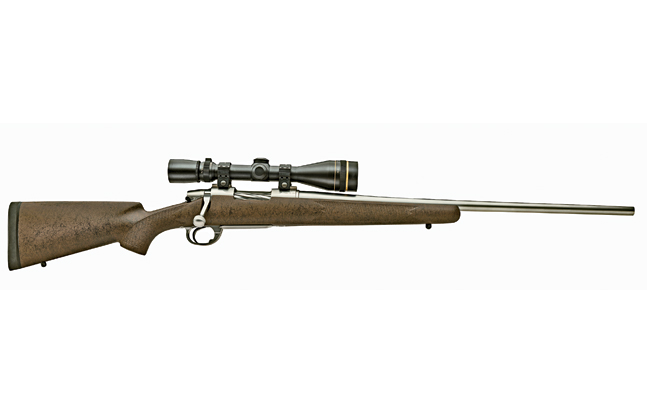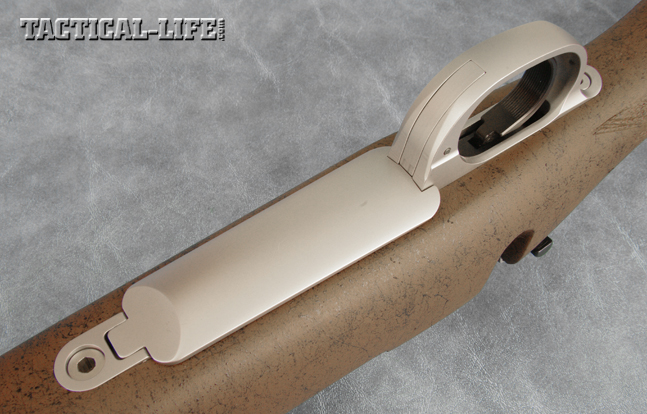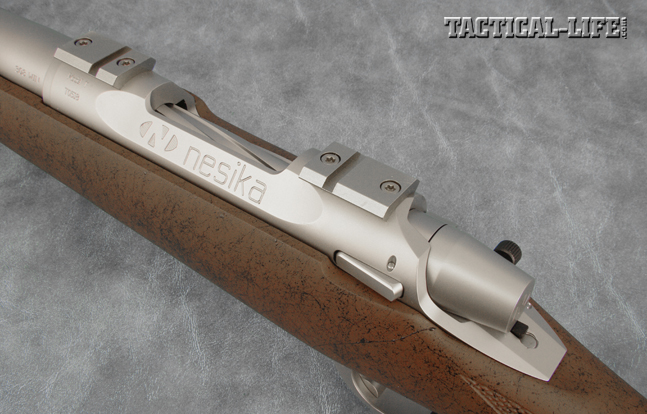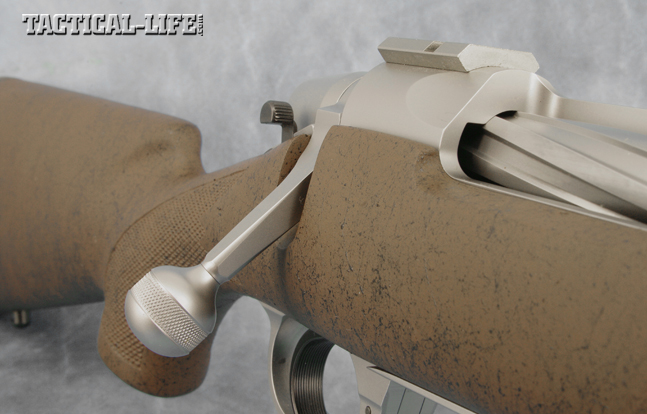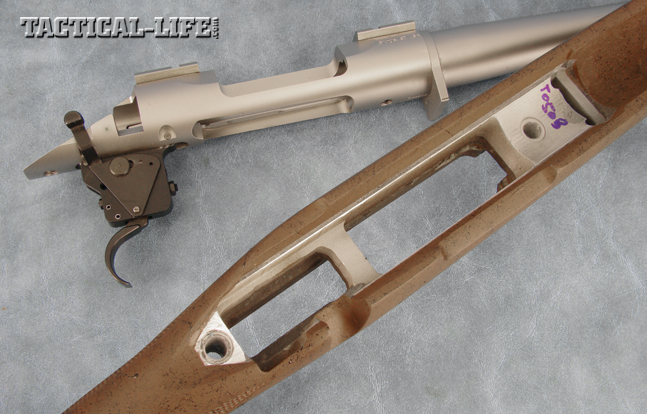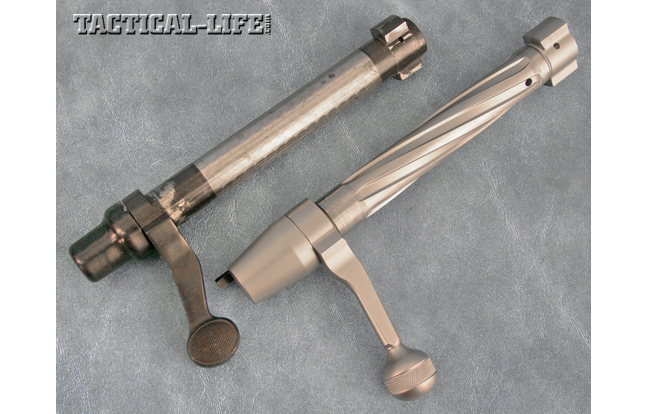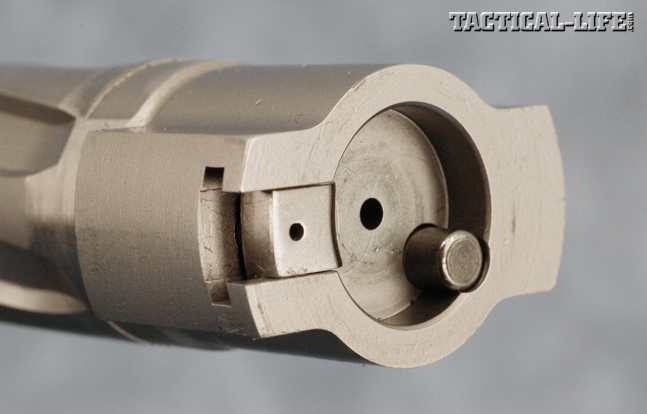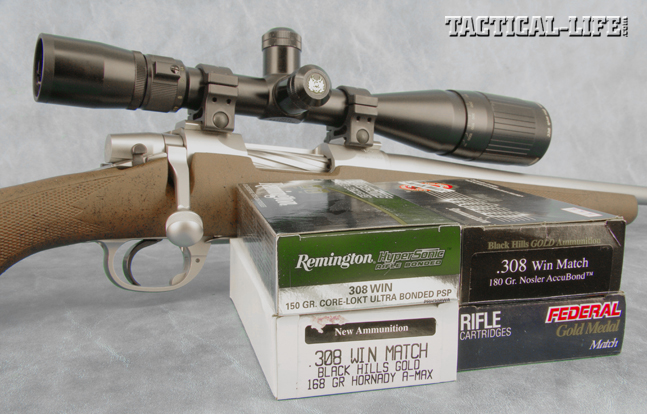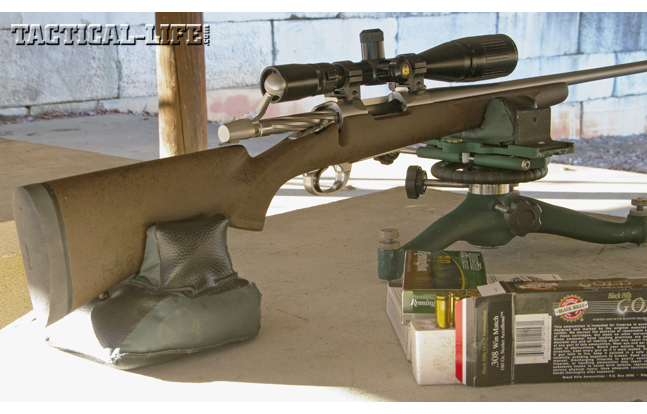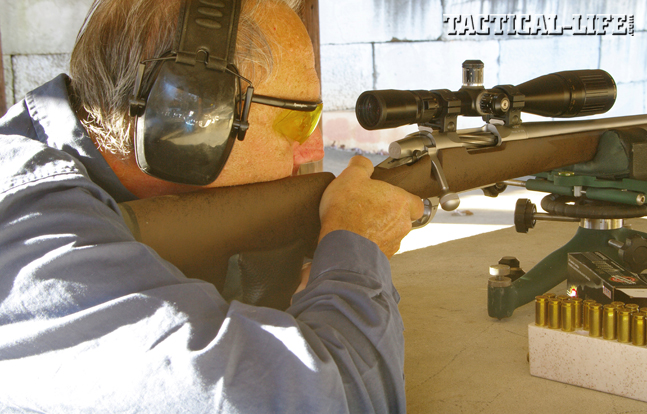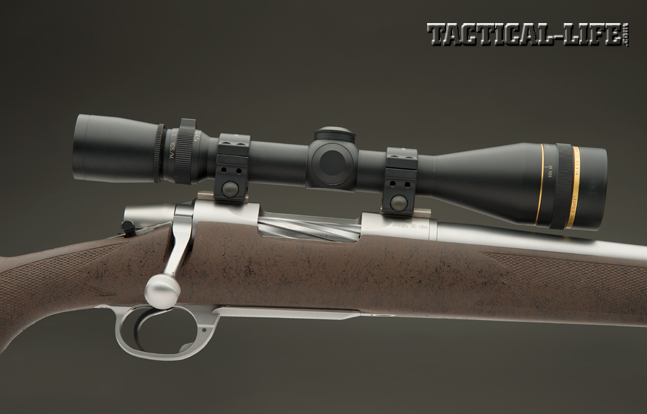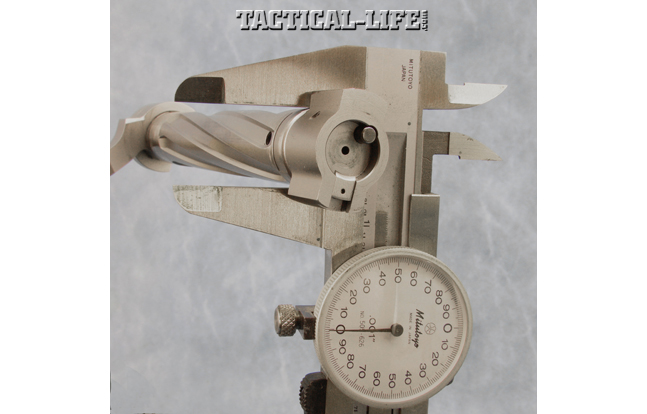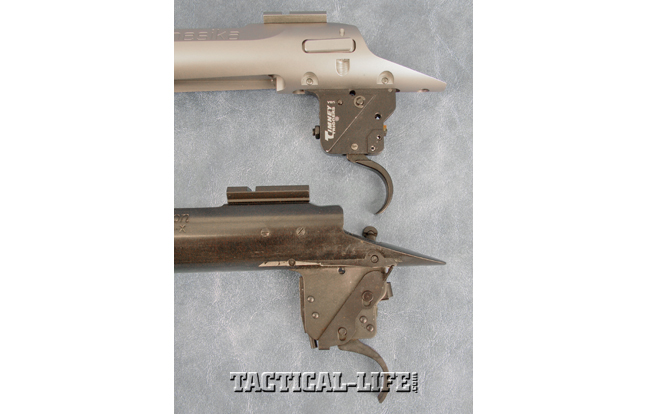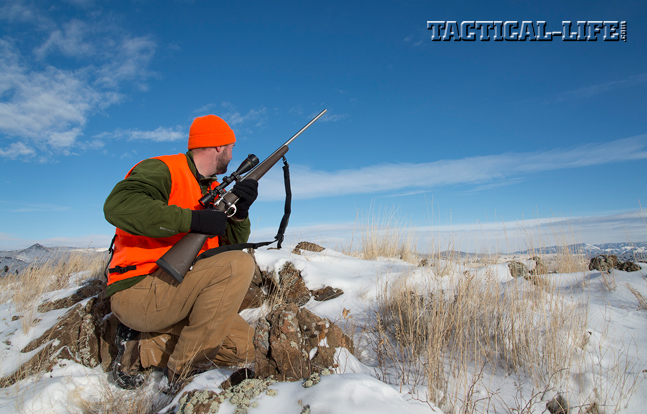The Nesika Sporter I was sent for testing came chambered in .308 Winchester. Out of the box, it weighed 8 pounds unloaded with a Remington-contour, 24-inch, match-grade Douglas barrel that measures 0.655 inches at the muzzle. My initial impression was that this is one beautifully machined and finished rifle. The matte stainless finish on the barreled action and on the hinged, all-steel bottom metal unit was perfectly uniform and superbly done. The same goes for the laid-up composite stock; it’s the Bell & Carlson Medalist model with an integral aluminum bedding block a la H-S Precision. The style is strictly neo-classic with a high, straight comb that’s parallel with the bore line, a cheekpiece and molded-in checkering panels done in a classic point pattern. Sling swivel studs and a Pachmayr Decelerator recoil pad are standard.
Those differences I spoke of between the Remington 700 and this action are found inside the receiver and on the bolt. First off, the two massive locking lugs at the head of the bolt are almost 0.13 inches longer than those on the 700, meaning that the combined shear surface is about 20 percent greater. If there’s a twin-lug action with greater shear surface than this one, I don’t know who makes it.
However, unlike the Model 700, which sports two locking lugs that are identical to one another, the face of the right-side locking lug on this action hosts an extractor that slides radially within a T-slot, so its shear surface is slightly less than that of the opposing lug. This difference is strictly technical minutia and of no practical concern whatsoever. Spent cases are ejected by the familiar plunger-type button in the lower-left quadrant of the bolt face.
Advertisement — Continue Reading Below
“The rear of the bolt is finished with a nicely shaped shroud that is wide enough to block the lug raceways so that any particle-bearing gases from a pierced primer or case head separation won’t reach the shooter’s face.”
Other interesting features about this and the other three Nesika actions is that all have “Borden Bumps” machined into the bolt body directly behind the locking lugs. Named after its inventor, Jim Borden, an accomplished engineer, machinist and benchrest shooter, the bumps, which cannot actually be seen because they are so subtle, reduce the lateral play between the bolt and receiver to 0.001 inches or less when in battery. It is a feature that has since been adopted by several other gunsmiths specializing in building actions and/or complete rifles for competition. The best way I can describe it is that the bolt body diameter is actually eccentric when measured directly behind the locking lugs. Behind the lugs, i.e., across the Borden Bumps, the bolt body measures exactly 0.7 inches, but if you turn the bolt 90 degrees, it measures 0.69 inches.
The receiver is machined from 15-5 stainless steel, and the one-piece bolt, with its integral handle, is made of 4340 chrome-moly. The latter can be ordered with spiral or straight flutes, or none at all. The bolt’s grasping ball is a separate component that’s threaded onto the handle. I especially like the fact that the handle is longer than that of most actions, and that it juts out farther from the side of the stock. Not only does this provide extra leverage on the opening stroke—a real plus when you’ve got a sticky case and you’re trying to cycle the bolt with the rifle shouldered—but it makes finding the handle that much easier. Some rifles have the bolt handle hugging the stock too closely and can be missed with the upsweep of the hand when trying to get off a rapid follow-up shot.
The rear of the bolt is finished with a nicely shaped shroud that is wide enough to block the lug raceways so that any particle-bearing gases from a pierced primer or case head separation won’t reach the shooter’s face. The firing pin tail has a rearward extension that juts out from beneath the shroud, indicating the action is cocked; otherwise, it can’t be seen or felt.
Advertisement — Continue Reading Below
The all-steel bottom metal unit is a thing of beauty. The floorplate is of the straddle variety, with the release lever inside the triggerguard bow. The magazine follower is also made of steel. As previously noted, the trigger is interchangeable with that of the Remington 700, but this one is made by Timney, so nothing more need be said as to its quality. The two-position, side-mounted safety does not lock the bolt, so when engaged, live rounds can be loaded and unloaded in safety. Unlike the Model 700, however, this action does not have the bolt release in the ceiling of the triggerguard bow; rather, it’s a pivoting lever housed in the conventional location on the left side of the receiver bridge. Depressing the rear end of the lever pivots the front end out of the raceway, allowing the bolt to be removed.
Continue Reading: Nesika Sporter .308 Winchester Rifle | Gun Review
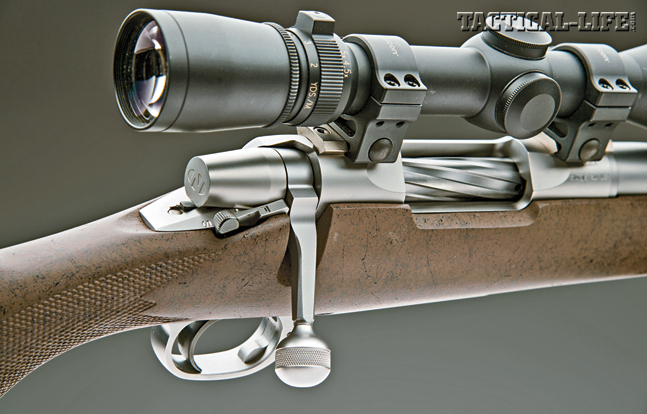
Nesika is a term the hunting fraternity may not be too familiar with, but that’s certainly not the case with competitive shooters. From benchrest to extreme-range events, rifles built on Nesika actions have set many accuracy records, among them a 1,000-yard, 10-shot group measuring 4.22 inches fired by Kyle Brown. I mean, putting 10 consecutive shots into 4.22 inches from well over half a mile away is hard to even imagine!
Advertisement — Continue Reading Below
“As similar as this rifle is to a Remington 700, however, it is not a clone, for there are many subtle differences evident in the design, dimensions and manufacturing processes.”
The action was designed by Glen Harrison, an avid benchrest shooter who at the time lived on Nesika Bay in the Puget Sound area. So, despite a name that strongly suggests Japanese origin, we’re talking an American product through and through.
At first Glen farmed out the machining work, then assembled the actions himself. In 2003, Dakota Arms, the prestigious rifle manufacturer based in Sturgis, South Dakota, acquired Nesika. And, of course, when Dakota became part of the Freedom Group in 2009, Nesika was part of the deal.
After the company got settled in at Dakota’s Sturgis factory and the actions were being machined there (there were three distinct versions by then), the new management began to explore the idea of building complete sporting rifles based on the Nesika design. After all, they were building high-quality Dakota rifles based on their own actions in the same building, so why not? To do so, however, the competition-styled action had to be modified for sporting applications. Using the Benchrest model as an example, the receiver was massive and had flat sides and a solid, flat bedding surface sans magazine cutout. The ejection port was of minimal size for the particular cartridge family involved, and the receiver ring and barrel shank were longer than normal to ensure better concentricity.
Advertisement — Continue Reading Below
The receiver footprint is by design virtually identical to that of the Remington Model 700. Moreover, any bottom metal units and accessory triggers that will fit the Model 700 are compatible with this action. As similar as this rifle is to a Remington 700, however, it is not a clone, for there are many subtle differences evident in the design, dimensions and manufacturing processes.
Continue Reading: Nesika Sporter .308 Winchester Rifle | Gun Review
Advertisement — Continue Reading Below
Making The Grade
I had an earlier opportunity to shoot one of these Nesika Sporters at the Bienville Plantation near White Springs, Florida. It too was chambered in .308 Winchester, and with it I shot some pretty spectacular groups, so my expectations for this example were high indeed.
“There’s a Nesika Sporter action on which one can build a hunting rifle in just about any caliber under the sun.”
The test gun came with matching, pre-installed, stainless-finished Weaver-style bases, which I used to mount a Nikon Monarch 6.5-20×44 scope using Trijicon tactical rings. This isn’t really the type of scope you’d normally choose for a hunting rifle, but high-power scopes do minimize aiming error, and I wanted to give the Nesika every chance to show what it could do. Furthering that thought, I chose to test it with match ammo as well as hunting loads. With the big scope aboard, the range-ready rig weighed 9 pounds on the nose.
Advertisement — Continue Reading Below
Over the course of firing nearly 80 rounds, the gun performed as one would expect of a gun of this price. The action cycled very smoothly and required only 3.5 pounds of uplift on the bolt handle to cock the firing pin—that’s about as light as it gets. As they always are, the Timney trigger was a delight, breaking crisply at 3 pounds without a hitch or discernible creep. As can be seen from the performance table, accuracy with all four of the loads tested was more than acceptable, but I couldn’t quite match some of the groups I was able to get when I’d shot it at Bienville. But that was a different rifle and we were using different ammunition. With there being over a hundred commercial loadings for the .308 Winchester, I’m sure there are dozens that will shoot better in this rifle than the ones I used. But then that’s always the case.
Again, this is one very fine rifle—handsome, well made and superbly finished. The .308 Winchester is one of six chamberings currently available for the Sporter; the others are 7mm-08, .280 Remington, .30-06, 7mm Remington Magnum and .300 Win. Mag. For both standard and magnum calibers, the MSRP is $3,499. As an action only, the Sporter is offered in all bolt faces, and in short, standard, and magnum lengths to accommodate calibers ranging from the .223 family to the big Lazzeroni and .338 Lapua Magnum. In short, there’s a Nesika Sporter action on which one can build a hunting rifle in just about any caliber under the sun, and they can be ordered in single-shot, hinged-floorplate or detachable-box versions.
For more information, visit nesikafirearms.com or call 605-347-4686.
Advertisement — Continue Reading Below
